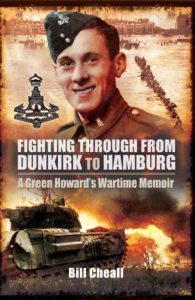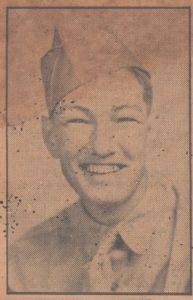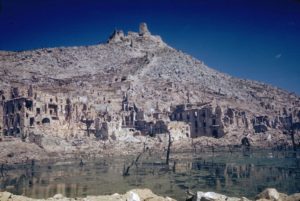The Rome-Arno Campaign – What was it like?
I never would have guessed—book lover that I’ve always been—that I would one day discover via podcast insights that had eluded me in all my reading.
Over the past few years Twitter has connect me with a quirky little community whose interests align with mine: reading, writing, the environment, travel, history, art, food. And above all, a topic I thought was not of interest to me…until it was: World War II.
I grew up surrounded by World War II Veterans—my mother’s four brothers, the fathers of friends and neighbors. But except for my Uncle Joe, no one talked about the War except for a passing comment here or there. I read voraciously, but mostly avoided books about World War II. I always knew I was a writer…and would someday write a book. But never thought I would write a book about World War II…until I did.
The Battalion Artist was and is, above all, a labor of love. I wrote it to honor the memory of Nat Bellantoni and to share his wartime story.
 On Twitter, I met others on similar missions. Among them, Paul Cheall. Paul’s father, Bill, penned an incredible memoir: Fighting Through from Dunkirk to Hamburg.
On Twitter, I met others on similar missions. Among them, Paul Cheall. Paul’s father, Bill, penned an incredible memoir: Fighting Through from Dunkirk to Hamburg.
In 2013 Paul launched a series of podcasts, now numbering 76. Paul’s podcasts are captivating. Addictive, actually. Each one includes recollections of others who also experienced what Paul calls “Dad’s War.” The breadth of topics Paul covers is just about limitless. Each “show” is thoroughly researched, rich in detail, presented with clarity, verve, and emotional depth.
When Paul offered to feature The Battalion Artist on one of his episodes, I was thrilled.
Episode #71, “The Battalion Artist, Seabees in the Pacific War,” first aired on September 16. Paul also included excerpts from the book in Episode #76, “Christmas at War.”
Since the very first time I listened to one of Paul’s podcasts I’ve been dipping in and out of his amazing array of content—jumping from #61 and #62 “Churchill’s Hellraisers by Damien Lewis” to #69, “German Boy Soldier Willi Langbein.”
Finally, I decided I’d best begin at the beginning.And so I went back to #1 “Dunkirk WW2 Veteran Bill Cheall’s story of the beaches, Second World War.” From there, I was progressing smoothly through the episodes in sequence…until I got halfway through #38. “Sergeant Eion McEwan of the 5th Scottish Paratroopers fought in France, Italy, Greece, Singapore and Indonesia.”
It was in Italy, that I stopped in my tracks, dumbfounded. Because it became all too clear to me that in addition to learning about Sergeant McEwan’s war, I was hearing the kind of details that had been omitted from every anecdote related to me or any other member of our family by my Uncle John.
 Up until very recently, my knowledge of Uncle John’s service in World War II was pretty sketchy. I knew that Uncle Joe had urged both his younger brothers to join the Navy as he had (because then they would “at least” have hot meals and a bunk to sleep in). But neither John nor Philip took Joe’s advice. John was rueful when he spoke about enlisting in July of 1942, at age twenty, rather than waiting to be drafted. “I asked if you could pick what you wanted to do if you joined up,” he recalled. Apparently, a recruiting officer said, “Yes.” But he meant, “No.” For John ended up in the Infantry.
Up until very recently, my knowledge of Uncle John’s service in World War II was pretty sketchy. I knew that Uncle Joe had urged both his younger brothers to join the Navy as he had (because then they would “at least” have hot meals and a bunk to sleep in). But neither John nor Philip took Joe’s advice. John was rueful when he spoke about enlisting in July of 1942, at age twenty, rather than waiting to be drafted. “I asked if you could pick what you wanted to do if you joined up,” he recalled. Apparently, a recruiting officer said, “Yes.” But he meant, “No.” For John ended up in the Infantry.
I knew that when he was sent overseas John first landed in Africa. From there, his unit, crossed the Mediterranean, landed in southern Italy and fought its way north. I did not know until his granddaughter delivered the eulogy at Uncle John’s funeral that he had been awarded three bronze stars. (Hoping to find out more, I sent away for Uncle John’s military records prior to the outbreak of the pandemic, but so far they have not arrived).
When my husband and I spent three weeks in Italy in 2018, we traveled by train from Rome to Venice. I kept looking out over the corrugated terrain—an endless succession of hills, mountains, valleys—and visualized my uncle and all those other young soldiers trudging over this landscape through all kinds of weather, chasing a relentless enemy, fighting for their lives every step of the way.
These musings were brought to life when I listened to Paul Cheall read from Eion McEwan’s diary. It began to dawn on me that what I was hearing was likely to be the best description I could hope to find of what the War in Italy was like for my Uncle John. My cousin had sent me a copy of John’s discharge, so I knew he had fought in three major campaigns: Rome-Arno, No. Apennines, and Po Valley. I went to my computer to search for battlefield maps. Sure enough, the positions of the British Eighth Army (Sgt. McEwan) and the U.S. Fifth (Uncle John) shared the same blue line.
After going back and listening, once again, to Paul Cheall reading from Eion’s diary for the first five months of 1944, I realized that many of these entries no doubt described much of what John would have experienced. Some excerpts:
• Moved to German flank – still under heavy mortar fire
• Moved back out of line for a few days rest
• Leave cut short – Jerry located in next village…ordered in…killed and captured several
• In trenches day and night – pouring with rain
• Marched seven miles in sleet and rain….
• Snowed up – had to clear one mile of roadway to get rations through
• Went to assist “C” company out of snowed up position
• Moved into concentration area
• Pinned down and could not move during daylight hours (freezing) could not have any hot meal or drink—
• On fighting patrol – wounded and captured two Jerries who gave us valuable information
• Jerry dive bombed and machine gunned our positions only minor injuries – rum ration
• Polish soldier surrendered to “D company
• Captured 2 prisoner and killed one Jerry using armor-piercing shells
• Frenchman surrendered to “D” company
• We were relieved by “C” company and moved back about two miles
• Good news today- commando landing 30 miles south of Rome
• Back in line again – we relieved D company
• Shelled like hell – rum ration –
• Stood to, following warning of Jerry platoon approaching – we opened fire and to our horror Jerry pushed Italian children in front of them and ran; we captured four
• Moved off by truck at 0700 hours. Traveled all day …
• Informed whole brigade being transferred to join in attack on Cassino
 [Paul interrupts to explain:] Listener, Cassino is towards the west coast about halfway between Rome and Naples. This was a huge battle over a strategic location on the way to Rome and took place Jan-May 44. It involved four assaults and 75,000 allied and German casualties.
[Paul interrupts to explain:] Listener, Cassino is towards the west coast about halfway between Rome and Naples. This was a huge battle over a strategic location on the way to Rome and took place Jan-May 44. It involved four assaults and 75,000 allied and German casualties.
During the battles, the ancient abbey of Monte Cassino… was entirely destroyed by Allied bombing and artillery barrages in February 1944.
• Moved forward during night into slit trenches. No water and not much food
• Shelled and mortared all day
• Poor old Todd killed. Direct hit on dugout
• Attended Church service – Padre came right up to front line to conduct service amide shellfire
• Massive attack on enemy – went in last night terrific barrage – shelling and machine gun fire
• Heaviest barrage of history last night when we put in our big thrust for Rome. 2,000 guns opened up for 40 minutes NON STOP firing
As I listened I was thunderstuck: So this is what the War must have been like for Uncle John!
https://www.fightingthroughpodcast.co.uk